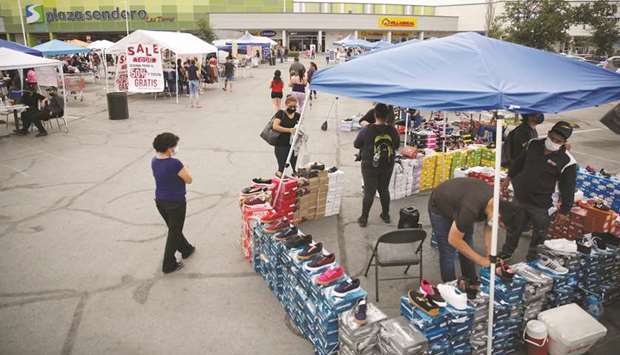Before travelling to Washington to meet Donald Trump earlier this month, the Mexican president took a coronavirus test.
Until then, Andres Manuel Lopez Obrador had never been tested, arguing that there was no need for it – even though several cabinet members had become infected with Covid-19.
The president, known as Amlo, took a second test on arriving in the US; both results were negative.
But testing has been rare in Mexico, even for people presenting Covid-19 symptoms at hospital and for the physicians, nurses and paramedics treating them.
“The WHO has said ‘test, test, test’ – but not even healthcare workers have access to tests,” said Rafael Soto, a nurse and spokesman for medical personnel protesting for healthcare improvements.“Many co-workers have died without ever having been tested.”
Mexico performs just three tests per 100,000 people, according to Johns Hopkins University’s dashboard; 66.9% of the results were positive on July 15, the last day data was available, according to Our World In Data.
Such a high positivity rate means “a government is only testing the sickest patients who seek out medical attention and not casting a wide enough net”, according to Johns Hopkins.
By comparison, the US performs 168 tests per 100,000 people. Exactly why Mexico refuses to test widely mystifies public health experts.
Some suspect the country’s thrifty president sees testing as a superfluous expense: Amlo has repeatedly predicted that the pandemic will end sooner rather than later, and has used the crisis to push through a package of deep cuts to government spending.
“It’s a strategy based on the idea of maximum savings – and it’s not producing results,” said Malaquías López-Cervantes, a public health professor at the National Autonomous University of Mexico (Unam).
Others believe Mexico’s government is attempting to copy the Swedish approach of minimising lockdowns to limit the pandemic’s economic impact – something Lopez Obrador has cited as important in a country where more than half the population work in the informal economy.
“The initial strategy of Mexico was definitely shooting for herd immunity,” said Laurie Ann Ximénez-Fyvie, head of the Unam molecular genetics laboratory.“Then they did everything possible to achieve that.”
As elsewhere, however, the strategy seems to have failed.
The country has registered more than 360,000 Covid-19 cases and more than 41,000 fatalities.
Its death toll recently passed those in Spain, France and Italy and it is fast approaching that of the United Kingdom.
After a short, non-obligatory quarantine, Mexico has already started to reopen its economy even though cases are still accumulating and the death toll racing to new records.
Mexico’s coronavirus tsar, Hugo Lopez-Gatell, has steadfastly opposed widespread testing, calling it “a waste of time, effort and resources”.He also has acknowledged undercounting is occurring, but has said that was not unusual during a pandemic.
Public health experts say the strategy has left Mexico flying blind.
Instead of testing, the country initially employed mathematical modelling, based on samples from 475 clinics around the country.
Lopez-Cervantes said that system did not provide information which was granular enough to make decisions at a local level.
In May, the government announced an ambitious plan under which 324 “municipalities of hope” – which supposedly lacked coronavirus cases – would be allowed to reopen.
International / US/Latin America
Mexico neglect of Covid-19 testing mystifies experts as cases surge

Shopkeepers sell their merchandise at the parking lot of a shopping plaza, where they are temporarily located, as the government has not announced a reopening date for shopping centres, during the coronavirus outbreak, in Ciudad Juarez, Mexico.
